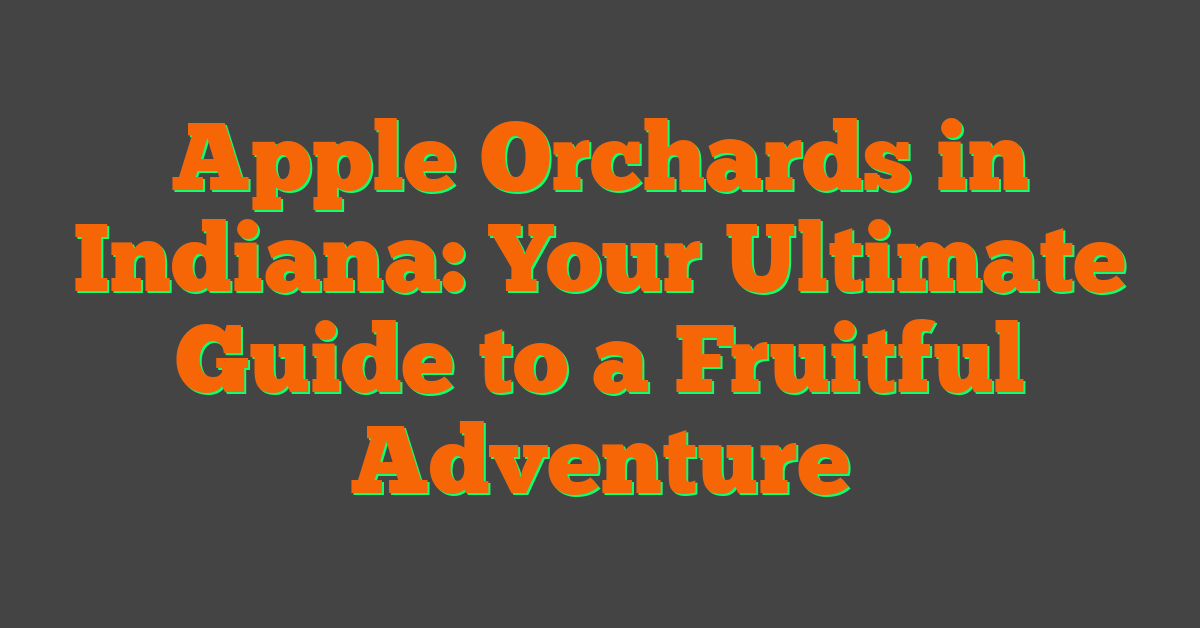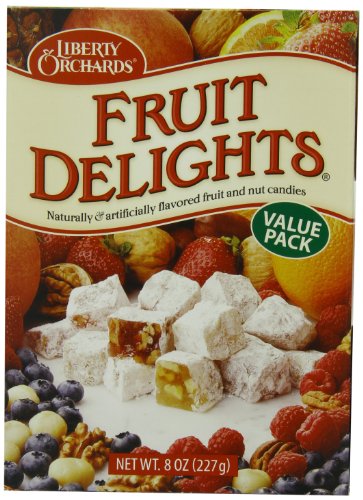There’s something delightful about the crisp air of an Indiana autumn, especially if you’re standing in an apple orchard. If you’ve never had this experience, it’s high time you make a change! Indiana is home to some truly remarkable apple orchards that offer more than just fresh fruit. You’ve got hayrides, corn mazes, farm animals and oh-so-much more.
Now imagine this: The leaves crunch under your feet as you meander through rows upon rows of apple trees. The sweet scent of ripe apples wafts through the air and every so often, there’s a gentle thud as one hits the ground. This isn’t just any day at the supermarket; this is an adventure that brings you closer to nature while offering mouthwatering rewards.
And let’s not forget about those warm cider donuts waiting for you back at the farm stand or perhaps a caramel-covered apple on a stick? Yes! It’s all part of the orchard experience in Indiana! No matter what corner of the state you’re exploring from Gary to Richmond – there are many opportunities to enjoy these fruitful delights during harvest season.
Understanding Indiana’s Apple Orchards
So, you’re curious about Indiana’s apple orchards? Well, there’s plenty to learn and a lot to love! Let’s dive in.
Indiana is home to around 60 apple orchards scattered across the state. Isn’t that a delightful surprise? These little pockets of apple trees contribute significantly to the state’s agricultural economy. But it’s not just about money – these orchards also have an important role in maintaining biodiversity and providing local communities with fresh, nutritious fruit.
Now get this – each year, these orchards yield approximately 1.5 million bushels of apples. That’s quite a number! To put it into perspective:
| Bushels | |
|---|---|
| Total Yield per Year (Approximate) | 1.5 Million |
Impressive isn’t it? This bounty includes several popular varieties such as Gala, Golden Delicious, Honeycrisp and Jonathan apples.
And here’s something else for you: many of these orchards are family-owned and operated businesses that have been passed down from generation to generation. They’re truly steeped in tradition!
- Beasley’s Orchard in Danville has been around since 1946.
- McClure’s Orchard in Peru was established over two decades ago by Jason McClure.
- Garwood Orchards, located in La Porte, has been farming apples since the late 1800s!
These establishments offer more than just crunchy apples – they provide memorable experiences like U-pick adventures, hayrides, corn mazes and annual fall festivals.
Isn’t it amazing how much there is to discover about Indiana’s apple industry? Whether you’re munching on your favorite variety straight from the tree or savoring a slice of warm apple pie baked with locally sourced fruit – remember to appreciate the hard work and rich history behind every bite!
Varieties of Apples Grown in Indiana
Let’s dive right into the heart of Indiana apple country, shall we? Amongst all states in the US, Indiana boasts a rich variety of apples. And guess what? They’re not just for munching on straight from the tree! Many are ideal for baking, juicing, or making into delicious cider.
First up is one you’ll likely recognize: the Golden Delicious. It’s a versatile option and it ripens in late September to early October. Then there’s the crowd-pleaser, Red Delicious. This apple is perfect for eating fresh and usually ripens around mid-September.
Next on our tour is Jonathan. Now this little gem matures earlier than most – usually by early September. Its tart flavor makes it great for baking pies that you won’t forget! Another favorite in these parts is McIntosh. Its sweet yet slightly tart taste makes it a hit for fresh eating as well as cider-making.
But wait, there’s more! Hoosiers also grow Granny Smiths (known for their crispness), Rome Beauties (excellent for cooking) and Fuji apples (sweet, crispy and great to eat raw).
There are numerous other varieties grown here too including:
- Winesap
- York Imperial
- Stayman
- Cortland
These less common types each add their own unique flavor profiles to Indiana’s apple landscape!
And let’s not forget about Honeycrisp – an apple so popular that it has its own fan base! This late-season variety typically matures in October and offers a sweet-tart flavor with juicy bite-sized explosions in every mouthful!
Now don’t get overwhelmed by all these choices because they represent only a fraction of what Indiana orchards offer! In reality, there are over 50 varieties planted across the state ensuring that no matter your preference, there’s always something new and exciting waiting at your local farm stand.
The Role of Climate on Indiana’s Apple Production
You might not know this, but the climate plays a huge role in determining the success of apple orchards. In fact, Indiana’s unique climate has a significant impact on its apple production. Let me tell you how.
Indiana experiences four distinct seasons which is crucial for apple trees. Winter gives the trees a rest period and prepares them for spring blossoms. During spring, moderate temperatures are necessary for the pollination process that happens with those beautiful blooms.
Now, let’s talk numbers:
| Season | Average Temperature (°F) |
|---|---|
| Winter | 29 |
| Spring | 54 |
| Summer | 75 |
| Fall | 55 |
The optimal temperature range for most apple varieties falls between 45-75°F during growing season — right in line with Indiana’s average summer temps!
But it’s not just temperature; rainfall also matters! It’s like free automatic watering system from Mother Nature herself. Too little rain can stress trees out while too much can lead to diseases or even waterlog apples causing them to split open before they’re ripe.
Here’s another quick table to show how much rainfall is typical throughout the year:
| Month | Average Rainfall (inches) |
|---|---|
| January | 2.1 |
| February | 2 |
| March | 3.1 |
| Figures continue monthly through December. |
So there you have it – some insight into why Indiana’s climate is like an apple tree’s best friend:
- Four distinct seasons
- Moderate temperatures
- Just-right rainfall
These factors all come together to create an environment where apples thrive and we get to enjoy their crunchy sweetness all fall long!
Famous Apple Orchards to Visit in Indiana
Let’s dive right into the heart of America’s Hoosier State, where apple orchards thrive and welcome visitors with open arms. You might be surprised by the variety and charm these orchards bring.
First up, we’ve got Beasley’s Orchard. This gem is located in Danville and has been serving the community since 1946! Not only do they grow a range of delicious apples like Honeycrisp and Gala, but they also host fun-filled events throughout the year. Their annual Heartland Apple Festival is a crowd favorite that you won’t want to miss!
I bet you didn’t know Indiana had its own “Apple Hill.” Well, it does – say hello to Apple Hill Orchard in Bruceville. It’s known for its sweet and tangy Zestar apples, which are perfect for all your pie-baking festivities. Every fall season, their pick-your-own apple experience draws families from across the state.
Next on our list is Anderson Orchard, nestled near Mooresville. Here’s an interesting tidbit: Anderson grows over 20 different types of apples! That’s quite impressive if you ask me. Plus, their Apple Festival & Craft Fair brings together local artists showcasing their creativity alongside mouthwatering apple treats.
Ever heard about an orchard that doubles as a winery? In Bloomington sits Oliver Winery & Vineyards, offering not just fantastic wines but also breathtaking views of beautifully maintained apple trees that make for an unforgettable visit.
And lastly, there’s no way we could leave out Garwood Orchards in LaPorte – it’s one of Indiana’s oldest family-owned farms dating back six generations! The Garwoods pride themselves on using sustainable farming practices resulting in some truly scrumptious apple varieties.
So there you have it — five standout orchards scattered across Indiana waiting for your visit. Whether you’re hunting for fresh apples or festive fun, these places surely deliver.
Harvesting Season for Apples in Indiana
Here’s a juicy fact you may not know, apple harvest season in Indiana usually kicks off as early as July and can extend up until November. It’s truly an exciting time of the year for all apple enthusiasts out there! The variety of apples ripening at different times throughout this period means that there’s always something fresh and delicious to enjoy.
To give some perspective, let’s break down the typical timeline:
- Early Season (July-August): This is when you’ll start seeing varieties like Lodi and Earligold. They’re perfect if you love your apples crisp and slightly tart.
- Mid-season (September): Things really start heating up now with favorites like Honeycrisp, McIntosh, and Gala making their appearance during this month.
- Late Season (October-November): This is the time for late bloomers such as Fuji, Granny Smith, and Goldrush.
Of course, it’s important to remember that weather conditions can significantly influence these timelines. A warm spring might mean an earlier harvest, while a cooler one could push things back slightly.
And guess what? In Indiana alone there are more than 50 apple orchards spread across the state! From Stuckey Farm Orchard in Sheridan to Anderson Orchard in Mooresville – each has its own unique charm and selection of apple varieties. So why not take advantage of the next harvesting season to embark on your own Indiana apple adventure? Trust me; it’ll be a journey packed full with mouth-watering moments!
Now remember folks – Mother Nature doesn’t operate by our calendars so these dates aren’t set in stone. But they do provide a general guide on when you can expect certain types of apples to be ripe for picking here in beautiful Indiana.
Economic Impact of Apple Orchards in Indiana
Indulging in an apple from Indiana isn’t just a treat for your taste buds, it’s also a boost to the state’s economy. Here’s how. Apple orchards provide more than just bushels of delicious fruit; they’re crucial economic drivers within the Hoosier state. These vibrant groves not only create jobs but also stimulate local economies by funneling profits back into the community.
Just take a look at some numbers to get an idea about this booming sector:
| Year | Number of Jobs | Total Revenue |
|---|---|---|
| 2015 | 1,200 | $30M |
| 2020 | 1,500 | $35M |
As you can see, in the span of five years, both employment and revenue from apple orchards have seen significant growth!
But that’s not all! There are other indirect benefits too. For instance, these orchards often become tourist attractions attracting visitors far and wide who contribute to local businesses like hotels and restaurants – another economic win!
What’s more? The cultivation process is also responsible for supporting ancillary industries such as manufacturing (think equipment), logistics (transportation), and even technology (agritech solutions).
- Manufacturing: As the demand for apples grows, so does the need for machinery to maintain these high-yielding orchards.
- Logistics: Once harvested, apples need transportation which provides job opportunities in trucking and distribution.
- Technology: Modern day farming incorporates advanced tech like GPS guided tractors or drones for surveying.
Therefore, don’t underestimate that sweet crunch when biting into an Indiana apple – it represents much more than just good health!
Laws and Regulations Surrounding Apple Orchards in Indiana
Did you know that running an apple orchard in Indiana isn’t just about planting trees and harvesting fruit? It’s actually wrapped up a lot more red tape than you might think. Understanding the legal landscape is crucial for any potential apple farmer.
To start, it’s important to be aware of the state’s zoning laws. Like most states, Indiana has specific zones for agriculture, which typically include areas designated for orchards. Before you start planting your trees, you’ll need to make sure your land falls within one of these zones or apply for a variance if it doesn’t.
Next on the list is pesticide regulations. You want those apples to be pest-free, right? Well, in order to use certain pesticides, you must obtain a Private Applicator License from the Office of Indiana State Chemist (OISC). This involves passing an exam and regularly renewing your license.
Your apples can’t just look good; they’ve got to taste good too! That means ensuring they’re ripe at harvest time. Believe it or not, there are rules about this as well. The USDA grades apples based on various factors like size and color but also ripeness.
Here’s something interesting – did you know there are even laws regarding how much water can be used by farms? Yep! In periods of drought or water shortage, restrictions may be put into place limiting irrigation practices.
Now let’s talk labor laws. If you’re hiring workers for your orchard (which most do), then familiarizing yourself with labor regulations is key. These cover everything from minimum wage requirements to worker safety measures.
So while growing apples might seem straightforward, being aware of these rules ensures that your orchard runs smoothly and legally:
- Zoning laws: Ensure land usage aligns with local agricultural designations.
- Pesticide regulations: Acquire a license from OISC.
- Ripeness rules: Adhere to USDA grading standards.
- Water usage limitations: Monitor consumption during dry periods.
- Labor laws: Maintain safe and fair working conditions.
It seems there’s a lot more than meets the eye when tending an apple orchard in Indiana!
Conclusion: The Future of Apple Orchards in Indiana
Let’s take a moment to gaze into the future of apple orchards in Indiana. With the growing appreciation for local, organic produce, there’s an exciting promise that lies ahead for the Hoosier state’s apple farms.
You might wonder what exactly this future looks like? Well, it’s all about embracing advanced farming techniques, diversification and increased community involvement.
Embracing Advanced Farming Techniques
First off, many farmers are now turning to more innovative farming methods. These include high-density planting and precision agriculture. Both these practices make use of technology to maximize production while minimizing waste. This means you’ll get your apples quicker and they’ll be grown in a sustainable manner too!
Diversification
Then there’s diversification – not just in terms of the types of apples grown but also how they’re used. Sure, apples are great on their own but have you ever tried hard cider from locally-grown apples? What about apple butter or even vinegar? Expect to see more of these products hitting your local markets as farmers tap into the potential of value-added products.
Increased Community Involvement
Lastly, expect greater community involvement with more pick-your-own options and farm festivals becoming commonplace at orchards across Indiana. There’s nothing quite like spending a day picking your own apples and learning firsthand how food makes its way from farm to table.
So there you have it! A peek into what lies ahead for Indiana’s apple orchards. It promises an era where technology meets tradition; where sustainability is key; and where communities come together over shared appreciation for homegrown goodness.












